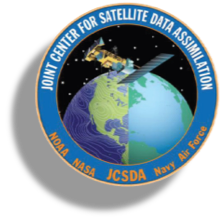Article by Zhiquan (Jake) Liu (NCAR/MMM), Chris Snyder (NCAR/MMM), Junmei Ban (NCAR/MMM), Jonathan (JJ) Guerrette (NCAR/MMM), Byoung-Joo (BJ) Jung (NCAR/MMM), Steve Vahl (JCSDA), and Yali Wu (NCAR)
Since 2018, a group of scientists and engineers at the Mesoscale and Microscale Meteorology (MMM) Laboratory of the National Center for Atmospheric Research (NCAR) have been developing a global data assimilation (DA) system for the Model for Prediction Across Scales – Atmosphere (MPAS-A) within the software framework of the Joint Effort for Data assimilation Integration (JEDI). Global JEDI-MPAS DA development is still underway as part of a US Air Force funded project named “PANDA-C” (Prediction AND Assimilation for Cloud) and in collaboration with JCSDA’s JEDI core team.
With the rapid development in the past three years or so, several JEDI DA schemes were tested with global JEDI-MPAS, including 3DEnVar, 4DEnVar, and 3DVAR for deterministic analysis and EDA (ensemble of DAs) for ensemble analysis. It also allows for dual-resolution DA, where the analysis increment and the input forecast ensemble can be at a lower resolution than that of the background and analysis for a more efficient iterative minimization process. Moreover, JEDI-MPAS analysis is done directly on MPAS unstructured grid and can be applied seamlessly to MPAS uniform and variable-resolution meshes.
On the observation side, JEDI-MPAS can assimilate most of observations enabled through the Unified Forward Operator (UFO) and the Interface for Observation Data Access (IODA), two model-agnostic components of JEDI. Special efforts were devoted to cloudy radiance DA from both microwave sensors and geostationary infrared imagers to improve cloud analysis and forecasting, which is the focus of the PANDA-C project. Month-long global cycling experiments with JEDI-MPAS demonstrated its robustness and great potential for NWP-based cloud analysis and forecasting.
More recently under NCAR internal funding, global JEDI-MPAS has been extended to work with regional MPAS. This extension is straightforward thanks to the unified code repository for global and regional MPAS and the model-agnostic design of those common components within the JEDI framework. One major addition for regional extension of JEDI-MPAS was to introduce a MPAS-specific quality control (QC) filter in UFO, which removes observations outside a regional MPAS domain. This regional QC filter, which at present works only for circular domains, will be expanded in the future for more general MPAS domains with arbitrary shapes. A 3DEnVar cycling experiment with regional JEDI-MPAS was conducted over a large (2800 km radius) domain centered over the US (Figure 1, below) with a uniform mesh of 15 km for the whole month of May 2019. Only conventional in-situ observations, satellite track winds and GNSSRO data were assimilated in this first trial of regional JEDI-MPAS. Figure 2 below shows the RMS time series of the background and analysis departures from aircraft temperature, u-/v-wind component, and specific humidity observations, which are stable over the month-long period even though the experiment is not necessarily with optimal settings.
Given the great progress of JEDI-MPAS development, it is expected to be released to the community this September.
Figure 1. Circular MPAS domain centered over the US with a uniform mesh of 15 km and 2800 km radius.
Figure 2. Time series of RMS of the background and analysis departures from aircraft temperature, u-/v-wind component, and specific humidity observations for the whole month of May 2019.


